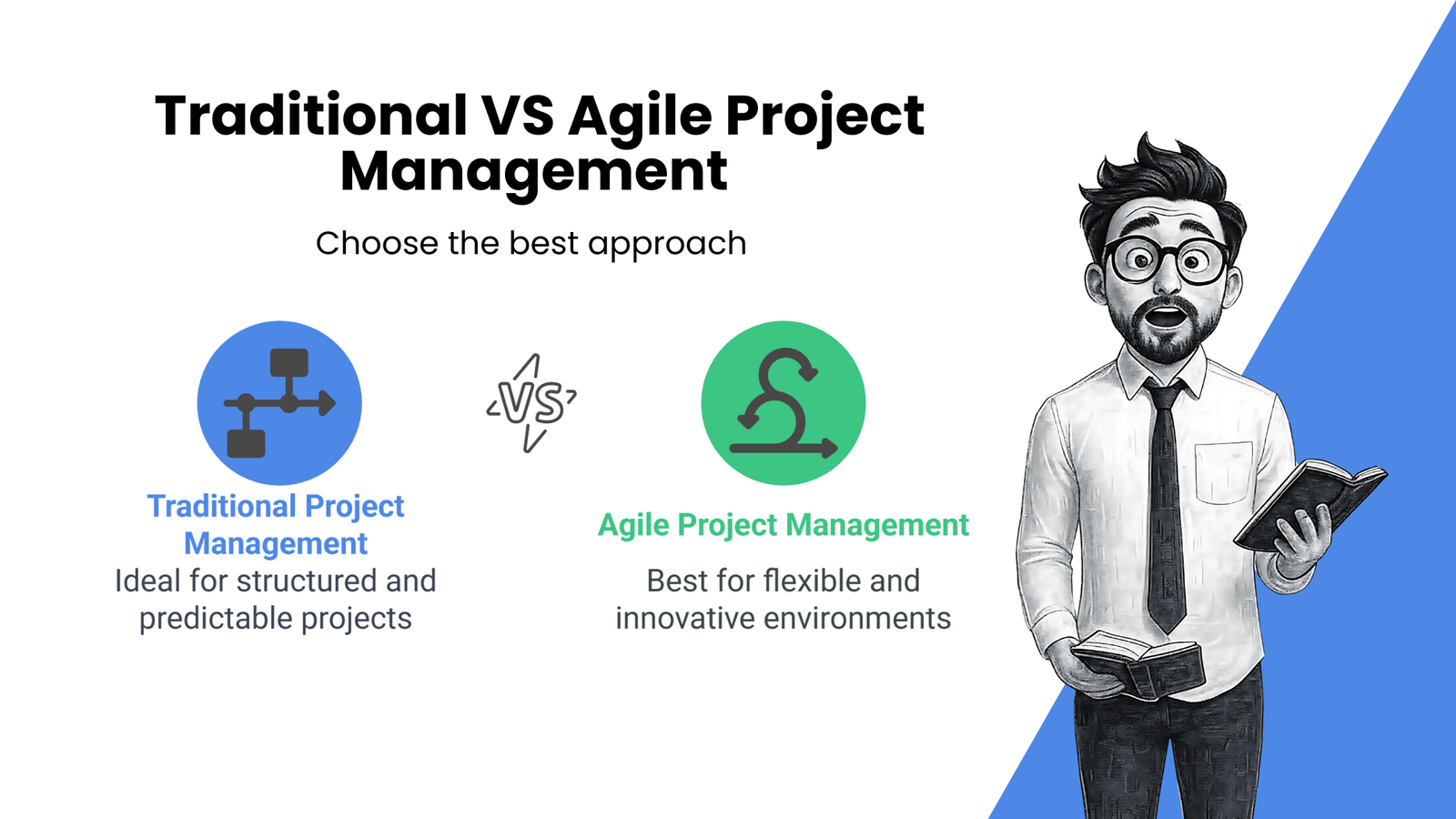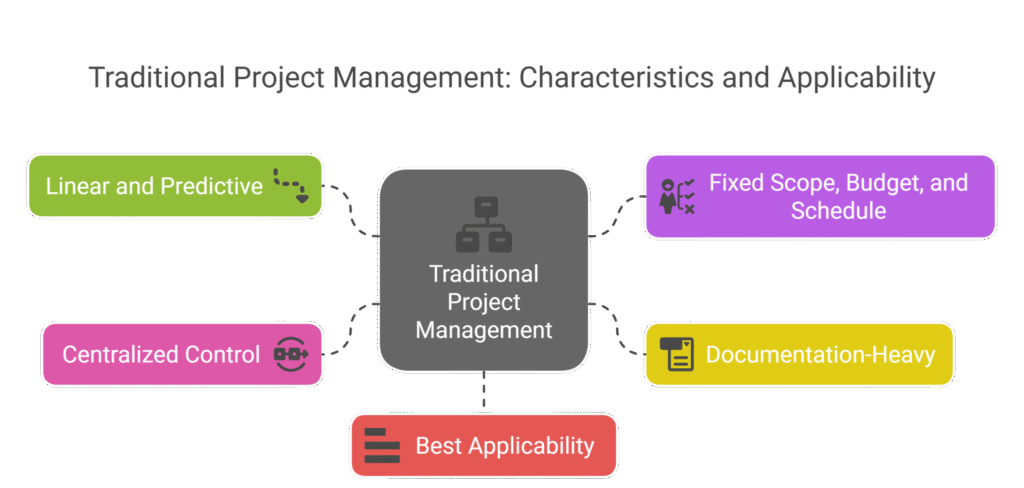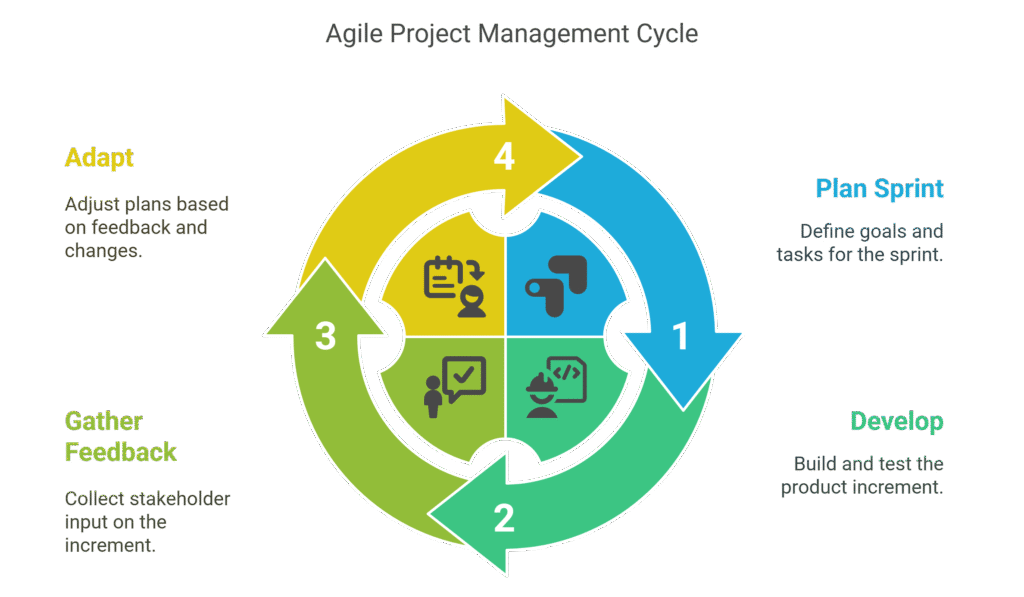
Project management has types, and all project managers should not be considered the same. The most popular methodologies of project management are traditional project management and agile project management. Irrespective of the merits and demerits of each methodology, the primary difference between traditional project management and agile project management is worth considering.
Knowing these is important for you, whether you are an upcoming project manager or in charge of your tenth team. Why? Because picking the right method can mean the difference between a project’s success and a never-ending backlog of work, between happy clients and angry teams, and between clarity and chaos.
What Is Traditional Project Management?
The Waterfall model, another name for traditional project management, is based on a straight line of steps. The job is completed one step at a time, from starting to planning to carrying out to monitoring to ending. It’s like building a house. First, you design everything on paper. Then you lay the foundation, build the frame, and so on. Once the roof is on, you’re not going back to change the blueprint.
The core characteristics of traditional project management are:
Linear and predictive: The path is planned from the start and rarely changes.
Scope, budget, and schedule are fixed: Deviations are discouraged.
Documentation-heavy: Every step is documented in detail.
Centralized control: The project manager has the authority to make decisions.
Best Applicability:
Traditional PM works well for projects with clearly defined goals, repeatable processes, and minimal expected changes, like:
Construction
Infrastructure development
Manufacturing
Legal or compliance-heavy initiatives

What Is Agile Project Management?
Software is where agile project management got its start, but it has spread to many other fields as well. It’s built on the Agile Manifesto and stresses being flexible, listening to customers, and always getting better. Agile breaks work up into short cycles called sprints. During these cycles, teams build, test, and make changes quickly. Of course, you’re still making a house, but after each room is done, you ask the owner what they think.
The core features of agile project management are:
Being progressive and flexible. Plans change based on what people say and what’s happening in real-time.
Cross-functional and inclusive teams: Everyone has a say in how decisions are made.
Minimal documentation: Working solutions are prioritized over paperwork.
Customer-centric: Stakeholders are involved throughout the project.
Best Applicability
Agile shines in dynamic environments where speed, innovation, and collaboration are priorities:
Software Development
Marketing Campaigns
Product Design
Startups and Innovation Teams

Agile Project Manager vs Traditional Project Manager
Now you know the best applicability of each methodology, but when and where to apply which one still remains a query. How do the project managers themselves differ from each other? It’s not just about tools; they take on very different roles depending on the method.
Quintessential Element Of Role | Traditional Project Manager | Agile Project Manager (Scrum Master / Agile Coach) |
Planning Approach | Detailed, fixed plan | High-level plan with room for change |
Team Management | Directs and oversees | Facilitates and empowers |
Decision-making | Centralized, top-down | Decentralized, team-driven |
Communication | Formal, periodic updates | Continuous and open |
Primary Goal | Deliver on time and on budget | Maximize customer value |
The debate on agile project managers vs. traditional project managers often boils down to one thing: control vs. flexibility. Traditional PMs control variables; agile PMs adapt to them. Choosing the right one prompts handing over the right kind of power to each one of them to supercharge your project execution processes.

Forms of Power in Project Management
No matter which method you follow, effective leadership depends on how you influence your team. That’s where the forms of power in project management come in. Project managers typically rely on a mix of these power types:
Legitimate Power: Authority from your role or title.
Expert Power: Predicated on your expertise.
Reward Power: Control over incentives like bonuses or promotions.
Referent Power: Use trust and respect to exert influence.
Coercive Power: Using pressure or threats (least effective long-term).
Informational Power: Control over key information.
Which Forms of Power do Traditional PMs Have?
Tend to lean more on legitimate and reward power due to their structured roles and hierarchy.
Which Forms of Power Do Agile PMs Have?
Rely more on expert, referent, and informational power, because they guide through collaboration rather than command.
What Makes Traditional and Agile Project Management Different?
Though at the surface level, both types of management seem quite similar, there are significant aspects that are unique to both approaches. The techniques in practice, the take on scope, the planning part, and execution part involve technicalities that are either inherently taken up for the role, while some are taken up with environmental factors. Let us run down the aspects for an in-depth analysis of both roles:
Aspect | Traditional PM | Agile PM |
Planning | Comprehensive, done at the beginning | Evolving, done continuously |
Execution | Sequential and phase-based | Iterative and incremental |
Flexibility | Low changes are discouraged | High changes are welcomed |
Customer Involvement | At the beginning and end only | Ongoing throughout the project |
Success Metrics | On-time, on-budget delivery | Customer satisfaction, team velocity |
Risk Management | Predictive and controlled | Adaptive and responsive |
Documentation | High volume of documents | Minimal documentation, more real-time feedback |
Which Project Management Methodologies Should You Use?
Well, there is no absolute answer to this question. The choice depends on several aspects and conditions, like your project goals, industry, team maturity, and stakeholder expectations. I can outline a questionnaire for you to figure out which strategy would suit you best in a few moments.
Before choosing, please ask yourself:
Is the end product clearly defined from the beginning?
Will requirements likely change over time?
How quickly do you need to deliver value?
Are your stakeholders available for continuous feedback?
You can also adopt a hybrid approach, blending both methodologies based on the project phase or nature of the work. This is increasingly common in large organizations that want the best of both methodologies.
Tips for Project Management
No matter what road you choose, here are some real-life project management tips that will help you do well:
1. Think about how you want to finish.
Figure out what success means to you, whether it’s meeting deadlines, making the client happy, or staying within price. This helps you choose the right method.
2. Know what your team does well.
It’s best for agile to work when teams can organize themselves and work together. When roles are clear and hierarchy is honored, traditional works well.
3. Communicate Early and Often
Keep stakeholders informed. Agile demands constant communication. Traditional projects benefit from structured updates and progress reports.
4. Stay Open to Learning
Even if you’re trained in one methodology, be curious about the other. The best project managers know how to switch gears when needed.
5. Keep the Customer at the Center
In both approaches, delivering value to the customer should guide your decisions, not just checking boxes or following a process.
How to Become a Project Manager?
There are many ways to learn how to become a project manager. Don’t just focus on one. Companies want to hire people who can switch between agile and traditional methods based on what the business needs.
Now, here’s an easy way to begin:
Get to know the basics: Learn about both agile project management (like Scrum or Kanban) and standard project management (like PMI’s PMBOK framework) by taking this course.
Learn how to: Think about getting a PMP (for standard) or CSM/PSM (for agile) certification.
Build experience: Take on small tasks or work as a shadow for experienced project managers to gain experience.
Join project communities: Learn from forums, LinkedIn groups, or PM events.
Improve your soft skills: Frameworks are important, but communication, leadership, and the ability to change are even more so.
Why This Difference Is More Important Than Ever?
Given the trends and approaches change every morning in the quest for doing something viral and different every day. So, adapting the right way is more important than it ever was before. Sticking to one approach can be risky when clients can change their thoughts, markets can change overnight, and teams can change in a few hours, months, or years.
So, it’s not just good for your resume to know the primary differences between traditional project management and agile project management. It also helps you lead smarter, produce better, and advance in your career faster. The real power comes from being able to pick the right method and lead with clarity, confidence, and purpose, whether you’re in charge of a complicated infrastructure build or a quick-moving tech launch.
Let’s Pick The Right Methodology For Your Project!
Given the differences between both approaches, exploring project management services for your upcoming project should not be a hassle anymore, because I am just a message away to assist you with the fundamentals. Being proficient in both standard and agile methodologies, I ensure I have a tailored solution to meet your best interests.
Reach out to discuss your upcoming project with me.